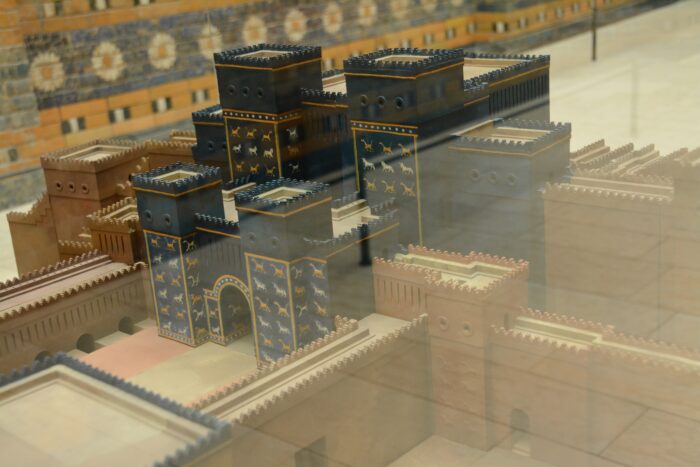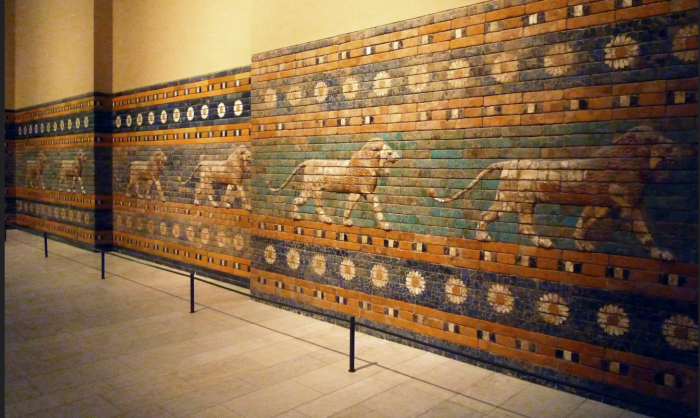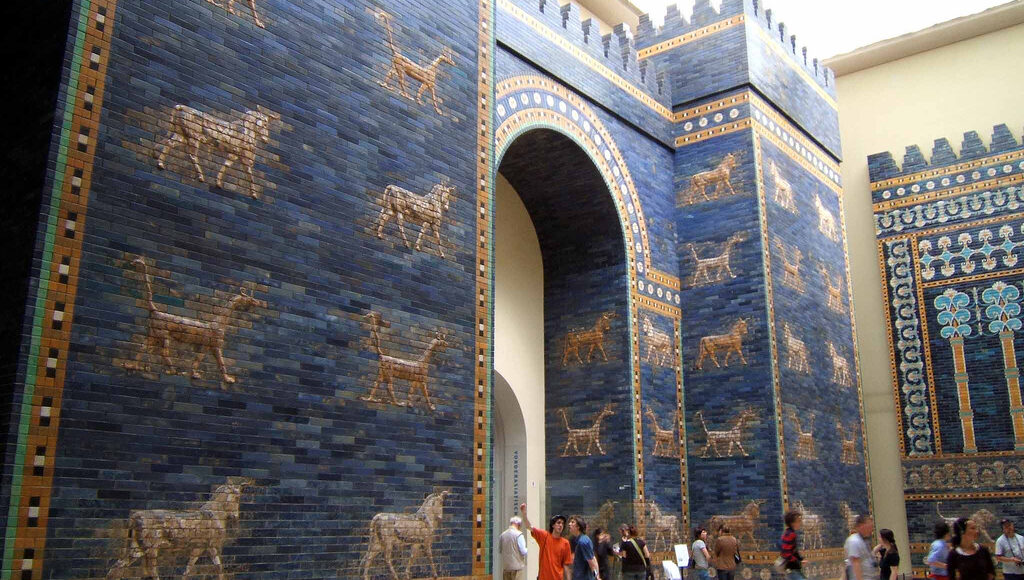Yes, Even Nebuchadnezzar Lied on His Resume
The Ishtar Gate, instantly recognizable for its vibrant blue hue, was once a dazzling display against the dull, monotonous desert sand. Nebuchadnezzar commissioned the gate, claiming in its inscription to have laid the “pure blue stone” himself. As impressive as such a massive lapis lazuli structure would be, the gate was actually constructed with glazed bricks, owing its blue-green tones to various metals.
Construction Blues
Long-lasting building materials in ancient Mesopotamia were often hard to come by. Unlike Egypt, whose quarries allowed the building of its famous, timeless monuments, the river valley of the Fertile Crescent had very little stone to use for construction. Instead, the Tigris and Euphrates Rivers contributed what they were best at—mud. So, sorry Nebuchadnezzar, but the gate isn’t constructed of stone at all; it’s made of clay bricks glazed with mixtures of metals and pigments.
Copper, iron, and cobalt are the main components of the deep blue glaze, and lead, copper, tin, antimony, iron, arsenic, and zinc contributed to the color of the turquoise bricks. While I know redox reactions were the bane of my existence in AP Chem and probably one of those things that you swore you’d never see again, here they are. To get copper to create a blue color, it must oxidize. Iron, on the other hand, must reduce by losing electrons and oxygen atoms. This leads scientists to believe that these two elements may have been mixed together beforehand—fritted, perhaps, if you’re a fan of Netflix’s Blown Away.
Lapis Lazuli: The True Space Stone
Nebuchadnezzar boasted that he built the Ishtar gate of pure lapis lazuli. Lapis is an incredibly precious stone that signaled not only wealth and power but also held “religious significance” for ancient Mesopotamians. The blue stone could only be mined in parts of modern-day Afghanistan, so its appearance in Mesopotamian art and artifacts communicated the wealth and reach of its various leaders who had the means to engage in trade across the region.
One of the Infinity Stones in The Marvel Cinematic Universe, the Space Stone, frequently appearing as the Tesseract, allowed characters to create portals and teleport across the universe. Possession of the Space Stone gave the bearer immense, literal power, while possession of lapis lazuli was a more subtle symbol of the far-reaching might of Mesopotamian rulers. This is probably a good thing, try to imagine Nebuchadnezzar’s ego trip if he had access to Infinity Stones!
Mesopotamians buried their elite with lapis lazuli, believing it would ease the journey from the living world to the underworld. Lapis lazuli would protect the bearer and encourage the gods to look more favorably upon the newly deceased. Through burial rituals and offerings of lapis lazuli, the Mesopotamians believed their dead could travel between worlds. They also believed that the upper tier of the heavens was made of the purest form of lapis lazuli itself. Lastly, Mesopotamian queens adorned themselves with lapis lazuli jewelry and considered each stone a piece of the heavens—a tiny, wearable portal to the stars.



The Gate and Powerful Ishtar
The goddess Inanna, known to the Assyrians as Ishtar, is the goddess of several contradictions. Her domain includes love, war, harvest, thunderstorms, and fertility. Ishtar was also the patron goddess of Babylon, so Nebuchadnezzar dedicated this impressive project to her.

The Ishtar Gate is one of the eight sets of double gates built to surround the city of Babylon and was in the running to be one of The Seven Wonders of the Ancient World. The gate was part of Nebuchadnezzar’s projects to rebuild the city of Babylon to its former glory, along with the hanging gardens and the great ziggurat—which may have been the source for the Tower of Babel!

Among the blue glazed bricks stride powerful creatures meant to symbolize the power and might of the king. Positioned regularly across the Processional Way leading up to the Ishtar Gate, nearly life-size lions, aurochs (a type of Mesopotamian bull), and dragons snarl, teeth bared at anyone who dares approach. The fearsome creatures symbolize the power of Nebuchadnezzar, for one who can control these magnificent predators must be incredibly powerful.


Not so powerful, however, that he could conjure tons of lapis lazuli to build his monuments. While we might understand why Nebuchadnezzar would appropriate the mythology and power of the precious stone, modern science has revealed the truth of the king’s fibbing.
Emma Silverman is a sophomore studying International Relations and Spanish. She enjoys trying out creative hobbies including metalworking and enameling, but, regrettably, has never attempted anything as large as the Ishtar Gate.
